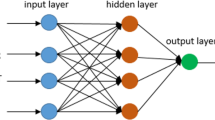Abstract
One of the most important issues in wireless sensor networks (WSNs) is to reduce energy consumption and increase the network lifetime. Proper election of cluster head is one of the approaches to reduce energy consumption in the network. Among existing methods, low-energy adaptive cluster hierarchy (LEACH) is the most prevalent routing algorithm, in which the cluster head is elected based on a given threshold. In LEACH algorithm, only the cluster heads are allowed to send information to the base station (BS). In this paper, a novel routing protocol based on super cluster head election using fuzzy logic in three levels (SCHFTL) is proposed, in which a super cluster head is elected among the cluster heads. The super cluster head election is performed based on a fuzzy description in three levels using Mamdani inference engine. Effectiveness of the proposed SCHFTL routing protocol is verified through MATLAB simulations in terms of death, time of the first node and network lifetime compared with LEACH, cluster head election mechanism using fuzzy logic (CHEF) and fuzzy-based master cluster head election leach (F-MCHEL) protocols.












Similar content being viewed by others
References
Akyildiz IF, Su W, Sankarasubramaniam Y, Cayirci E (2002) Wireless sensor networks: a survey. Comput Netw 38:393–422
Yick J, Mukherjee B, Ghosal D (2008) Wireless sensor network survey. Comput Netw 51:2292–2330
Omar M, Yahiaoui S, Bouabdallah A (2016) Reliable and energy aware query-driven routing protocol for wireless sensor networks. Ann Telecommun 71(1):73–85
Espes D, Lagrange X, Suárez L (2015) A cross-layer MAC and routing protocol based on slotted aloha for wireless sensor networks. Ann Telecommun 70(3):159–169
Martirosyan A, Boukerche A, Pazzi RWN (2008) Energy-aware and quality of service-based routing in wireless sensor networks and vehicular ad hoc networks. Ann Telecommun 63(11):669–681
Heinzelman WR, Chandrakasan A, Balakrishnan H (2000) Energy-efficient communication protocol for wireless microsensor networks. Proceedings of the 33rd Hawaii International Conference on System. Sciences:1–10
Akkaya K, Younis M (2005) A survey on routing protocols for wireless sensor networks. Ad Hoc Netw 3(3):325–349
Heinzelman WB, Chandrakasan A, Balakrishnan H (2002) An application-specific protocol architecture for wireless microsensor networks. IEEE Trans Wirel Commun 1(4):660–670
Smaragdakis, G., Matta, I., Bestavros, A. (2004). SEP: a stable election protocol for clustered heterogeneous wireless sensor networks. Second International Workshop on Sensor and Actor Network Protocols and Applications, 251-261
Manzoor B, Javaid N, Rehman O, Akbar M, Nadeem Q, Iqbal A, Ishfaq M (2013) Q-LEACH: a new routing protocol for WSNs. Procedia Computer Science 19:926–931
Nayak P, Devulapalli A (2016) A fuzzy logic-based clustering algorithm for WSN to extend the network lifetime. IEEE Sensors J 16(1):137–144
Jiang CJ, Shi WR, Tang XL, Wang P, Xiang M (2012) Energy balanced unequal clustering routing protocol for wireless sensor networks. Journal of Software 23(5):1222–1232
Mitton N, Fleury E, Lassous IG, Tixeuil S (2005) Self-stabilization in self-organized multihop wireless networks. IEEE International Conference on Distributed Computing Systems Workshops:909–915
Javaid N, Bibi A, Javaid A, Malik SA (2011) Modelling routing overhead generated by wireless proactive routing protocols. IEEE GLOBECOM Workshops:1072–1076
Javaid N, Ullah M, Djouani K (2011) Identifying design requirements for wireless routing link metrics. IEEE Global Telecommunications Conference:1–5
Javaid N, Bibi A, Javaid A, Khan ZA, Latif K, Ishfaq M (2014) Investigating quality routing link metrics in wireless multi-hop networks. Ann Telecommun 69(3):209–217
Sharma T, Kumar B (2012) F-MCHEL: fuzzy based master cluster-head election leach protocol in wireless sensor network. International Journal of Computer Science and Telecommunications, 3. Issue 10:8–13
Mostafa B, Saad C, Abderrahmane H (2013) Fuzzy logic approach to improving stable election protocol for clustered heterogeneous wireless sensor networks. Journal of Theoretical and Applied Information Technology 53(3):334–339
Anno J, Barolli L, Durresi A, Xhafa F, Koyama A (2008) Performance evaluation of two fuzzy-based cluster head selection systems for wireless sensor networks. Mob Inf Syst 4(4):297–312
Kim JM, Park SH, Han YJ, Chung TM (2008) CHEF: cluster head election mechanism using fuzzy logic in wireless sensor networks. International Conference on Advanced Communication Technology:654–659
Gajjar S, Sarkar M, Dasgupta K (2014) Cluster head selection protocol using fuzzy logic for wireless sensor networks. International Journal of Computer Applications 97(7):38–43
Seyedkolaei AA, Zakerolhosseini A (2014) CFMTL: clustering wireless sensor network using fuzzy logic and mobile sink in three-level. Advances in Computer Science: An International Journal 3(6):23–28
Wu J, Zhang L, Bai Y, Sun Y (2015) Cluster-based consensus time synchronization for wireless sensor networks. IEEE Sensors J 15(3):1404–1413
Bagci H, Yazici A (2010) An energy aware fuzzy unequal clustering algorithm for wireless sensor networks. In: IEEE International Conference on Fuzzy Systems, pp 1741–1749
Zhou H, Ying H (2013) A method for deriving the analytical structure of a broad class of typical interval type-2 Mamdani fuzzy controllers. IEEE Trans Fuzzy Syst 21(3):447–458
Suh B, Berber S (2013) Asynchronous data-forwarding strategy to reduce forwarding delay in energy-harvesting wireless sensor networks. Electron Lett 49(7):1492–1494
Angrisani L, Ventre G, Peluso L, Tedesco A (2006) Measurement of processing and queuing delays introduced by an open-source router in a single-hop network. IEEE Trans Instrum Meas 55(4):1065–1076
Author information
Authors and Affiliations
Corresponding author
Rights and permissions
About this article
Cite this article
Ayati, M., Ghayyoumi, M.H. & Keshavarz-Mohammadiyan, A. A fuzzy three-level clustering method for lifetime improvement of wireless sensor networks. Ann. Telecommun. 73, 535–546 (2018). https://doi.org/10.1007/s12243-018-0631-x
Received:
Accepted:
Published:
Issue Date:
DOI: https://doi.org/10.1007/s12243-018-0631-x




